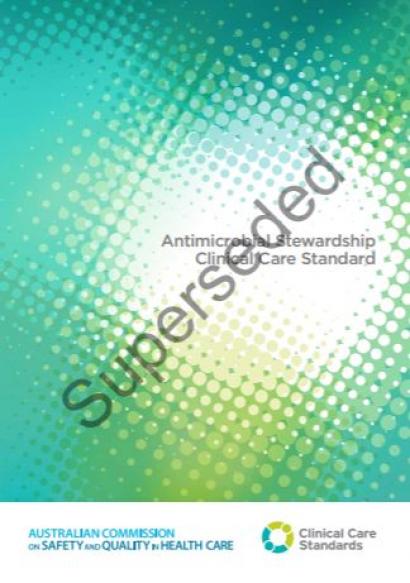This National Standard describes best practice care for the prevention, recognition and management of third and fourth degree perineal tears.
List of expert advisory groups for the Third Australian Atlas of Healthcare Variation, published in 2018.
Surgical antimicrobial prophylaxis is the use of antimicrobials to prevent infections that may occur as a result of a surgical procedure. This page provides information on the appropriateness of this prescribing.
The Commission has developed a range of tools and resources to help health service organisations deliver comprehensive care in alignment with the Comprehensive Care Standard.
To support a shared understanding of the Comprehensive Care Standard, the Commission has developed a conceptual model describing the key organisational requirements for supporting the delivery of comprehensive care in health services.
The majority of antimicrobial use in Australia occurs in the community, that is in general practice, community health services, aged care homes and other non-hospital settings.
This page includes links to Australian and international resources to support antimicrobial stewardship (AMS) programs in health service organisations and in aged care and primary care. AMS programs help to improve patient safety and in the prevention and control of antimicrobial resistance (AMR).
Antimicrobial Stewardship in Australian Health Care (the AMS Book), initially published in 2018, continues to be updated and enhanced with additional evidence, information, and topic areas to inform antimicrobial stewardship (AMS) strategies, interventions, and implementation across a range of healthcare settings.
Based on advice, feedback and discussions with clinical experts and health services from across Australia, the Commission has compiled a list of FAQs and resources that may assist health services in the prevention and reduction of hospital-acquired complications (HACs).
Explore these resources and share your feedback.
Effective surveillance of antimicrobial resistance (AMR) in acute and community settings informs strategies for infection prevention and control and antimicrobial stewardship (AMS).
This national standard describes best practice care for the care of cataract including referral, assessment, decisions about surgery and post-operative care.
Data on antimicrobial use in Australian hospitals are collected by the National Antimicrobial Prescribing Survey (NAPS) and the National Antimicrobial Utilisation Surveillance Program (NAUSP).
NAPS also collects data on antimicrobial use and infections in aged care homes.
More than 900,000 colonoscopies are performed in Australia annually. The Colonoscopy Clinical Care Standard describes the safe, appropriate and high-quality use of colonoscopy.
APAS collects, analyses and reports on de-identified patient-level antimicrobial resistance (AMR) data from routine susceptibility testing results.
AGAR collects, analyses and reports on antimicrobial resistance (AMR) data on selected priority organisms that cause bloodstream infections.
This page provides resources and a reference table of medication safety alerts, notices and guidance issued by the Australian states and territories and by international organisations using the APINCHS classification. There could be other more recent alerts, advice and guidance related to other medicines or practice areas which may be relevant to you or your organisation.
High risk medicines (HRMs) are medications that have an increased risk of causing significant patient harm or death if they are misused or used in error.1

